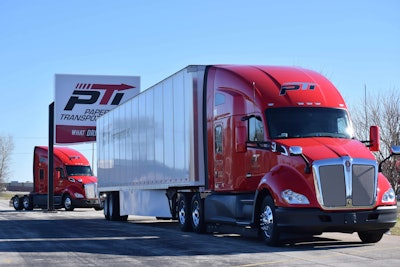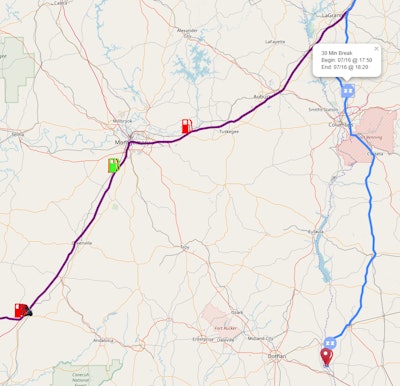CCJ Innovators profiles carriers and fleets that have found innovative ways to overcome trucking’s challenges. If you know a carrier that has displayed innovation, contact CCJ Editor Jeff Crissey at [email protected] or 800-633-5953.

For years, GPS-based breadcrumb reports have been a staple of fleet management technologies. The reports show a visual progression of historical driver locations to help identify areas of risk or inefficiency.
Where the reports often fall short is identifying in-transit loads that are running ahead of or behind schedule. They also do not eliminate guesswork or manual data entry from drivers’ trip planning processes.
Fleets typically require drivers to send macro messages to update their projected time available, and load planners and dispatchers use these driver PTAs to assign work. Drivers include future transit times, hours-of-service breaks, fuel stops and detention in their estimates.
Leadership at Paper Transport Inc. (CCJ Top 250, No. 136) saw an opportunity to develop technology that flips the breadcrumb trail in the opposite direction. Instead of reporting what happened, the new technology gives drivers forward-looking breadcrumbs for trip planning and provides customers with accurate ETAs for greater shipment visibility.
Charting a path
PTI, which currently operates 750 power units, says its growth has contributed to a younger driving force compared to industry demographics. Ben Schill, vice president of the De Pere, Wis.-based truckload carrier, says PTI drivers average 45 years old and have less than two years of tenure.
 For every work assignment, PTI drivers can view a simulated trip plan on a digital map.
For every work assignment, PTI drivers can view a simulated trip plan on a digital map.The company traditionally has paired new drivers with trainers for onboarding. While drivers learn trip planning from trainers, they may need years of experience to master those skills on their own, Schill says.
With the new technology, PTI has shortened the learning period for trip planning to the click of a button. For every work assignment, drivers can view a simulated trip plan on a digital map.
Drivers instantly can see where and when they will arrive at customers, fuel stops and HOS rest break locations, among other insights.
PTI released the first version of its smartETA technology in January. The application calculates travel and dwell times for every trip segment by using current and future load assignments, real-time and historic locations, HOS and various routing constraints.
Developing smartETA required “a lot of spatial data analysis,” says Peter Covach, director of information technology. The analysis uses data from PTI’s own database of millions of trip segments completed by drivers, as well as dwell times at geofenced customer locations. It also uses historical and real-time data from the fleet’s electronic logging device application.
Analysis of these and other data points has created machine learning algorithms that can predict accurate travel and dwell times for every shipment in PTI’s network.
A competitive advantage
Some commercial routing and navigation products are able to calculate ETAs using similar data points and techniques, but Covach says PTI management saw an opportunity to build its own technology to have a competitive advantage. “There are other providers, but we didn’t believe they were as precise,” he says.
Accurate ETAs are helpful when drivers are planning where to take their 30-minute or 10-hour breaks for HOS compliance. The technology can identify patterns and make recommendations.
“We are seeing that multiple drivers like to take breaks in the same locations,” Covach says. With this insight, the technology can recommend locations and identify opportunities to swap loads to prevent late deliveries.
Another reason PTI developed the technology in-house was to predict more accurate dwell times at locations that are specific to its customers and types of freight.
“Our vision was to have minute-by-minute predictions of where drivers and loads will be,” Schill says.
Measuring performance
Several years ago, PTI developed a custom mobile driver app that runs alongside a third-party fleet management platform. The commercial platform provides PTI’s core messaging, scheduling and ELD applications and serves as a “springboard to build in our own functionality,” Covach says.
 Peter Covach, IT director for Paper Transport, says management saw an opportunity to build its own technology to have a competitive advantage.
Peter Covach, IT director for Paper Transport, says management saw an opportunity to build its own technology to have a competitive advantage.“We don’t want to be an hours-of-service provider,” Covach says. “What we do want is to tack on our additional pieces to add additional value.”
Using the mobile app, drivers access their new trip view map by clicking a button in the “work assignments” feature. The view “gives drivers something to start with, but they do not have to follow the plan exactly like that,” Schill says.
As drivers progress on a route, smartETA continuously recalculates their arrival times and updates the trip view display. Drivers also can view their route performance.
A separate driver scorecard app reviews their daily performance in several measurement categories. Drivers can see where they rank and track their progress toward a monthly reward.
One scorecard measurement is for route compliance. In the past, the measurement PTI used for out-of-route mileage was the difference between billable and odometer miles. The app now gives drivers immediate feedback on out-of-route mileage based on the route drivers took compared to the prescribed route, as well as routes that other drivers took.
“This is a way to give our drivers another set of directions,” Schill says.
Proactive service
The benefits of smartETA go beyond trip planning. By accurately predicting ETAs, PTI is able to predict which shipments in its network will be on time and which ones will be late.
PTI’s customers can use an online portal to view current shipment status. A dashboard separates in-transit orders into three categories: loads that are tracking on time, loads within one hour of on-time delivery, and loads that will be late.
PTI also created an internal report that identifies loads in its network that will be late no matter what. Its customer service team uses this “toast report” to notify customers of late deliveries in advance, Schill says.
The fleet also provides customers with automated tracking information through their preferred formats. Some customers use web service integration to receive ETA updates every hour, while others prefer traditional EDI status information. Some receive updates through PTI’s integrations with freight visibility applications from third-party vendors, Covach says.
Future roadmap
Six months after smartETA’s implementation, PTI management has plotted a number of future enhancements. “We see this as a critical cornerstone to a lot of things we can do in the future,” Schill says.

Schill also sees an opportunity to predict ETAs more accurately based on the performance of individual drivers. Some drivers may have a tendency to stay longer at particular truck stops, he says.
For now, PTI is focused on training drivers to use the current trip planning tool. Management plans to begin pushing training to drivers at multiple times within the first three months on the job.
“Prior to really pushing it, we sent it out and have been getting a bunch of feedback while working on specific examples that needed some tweaking and fine-tuning,” he says.
The next big evolution for smartETA will be integrating it with the company’s turn-by-turn navigation app, which will give drivers a live view of ETAs and trip planning recommendations.
“I’m excited over the future of (smartETA),” Schill says.











